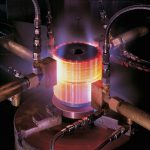
Precipitation hardening is a heat treatment process applied to various alloys to significantly increase their yield strength. Rather confusingly, the same process is also described as ageing or age hardening – in our comprehensive ‘Product Reference Guide’ we state the condition of such alloys as ‘Solution Annealed & Precipitation Treated’ to hopefully avoid confusion.
The process of solution annealing is applied to most alloys after their final forging or rolling process. By holding the particular alloy at a relatively high temperature for several hours – typically around 1000degC – all of the different elements within the alloy are absorbed into the solid solution. By then immediately quenching the bar or plate, the structure is retained at room temperature.
However, with the encouragement of time spent at elevated temperatures, the solubility of certain elements in the alloy will change. This means that precipitates – combinations of selected elements – come out solution and appear as small particles distributed throughout the alloys microstructure. The precipitate particles act to ‘pin’ grain boundaries within the microstructure of the alloy, which hinders their movement when the alloy is being strained. This increases the yield strength of the alloy. Depending upon the combination of temperature and time used for the ageing heat treatment, both the number, size and distribution of precipitates can vary. Therefore, it is possible to produce a range of different strength levels within the same alloy composition, purely by altering the temperature and time of the ageing heat treatment.
The ageing heat treatment can involve holding the bar or plate at a single temperature for a period of time, or holding it at different temperatures for different times. The cooling rate after removal from the furnace can also influence the nature of the precipitation process, so some alloys will be slowly air cooled whilst others are quenched (in oil or water).
The precipitation process relies upon complex thermodynamics – previously alloys were developed through experimentation and testing, but can now be optimised by the ability to model different alloy compositions and how precipitates form during different thermal histories.
High strength alloys are an attractive proposition for many applications. The ability to design components that fully exploit higher-strength alloys allows customers to reduce the overall material requirement, saving cost and time. In addition, lighter components can contribute savings in other areas, for instance suspended loads are reduced, thereby reducing the impact upon ancillary systems.
Langley Alloys stocks a number of high strength alloys that rely upon precipitation hardening to achieve their increased strength levels. These include:
Alloy K500 (2.4375, UNS N05500, Monel K500) – a nickel-based alloy with copper. Aluminium and Titanium are added to the alloy to specifically form ‘ϒ’ Ni3 (Ti, Al) precipitates. The secondary heat treatment is a two-stage process followed by slow air cooling.
Alloy 718 (2.4688, API 6ACRA, UNS N07718, Inconel 718) – is perhaps the most widely used precipitation hardened nickel alloy. Niobium, Titanium and Aluminium are all added to form a series of precipitates with Nickel. It can be supplied in a variety of different strength levels depending upon the nature of the heat treatment. The majority of our stock is the ‘120ksi’ version with a minimum yield strength of 125ksi (827N/mm2).
Alloy 725 (UNS N07725, API 6ACRA , Inconel 725) – this is the higher-strength variant of Alloy 625. The chemical composition s largely the same, apart from the addition of Niobium and titanium, to precipitate with nickel after heat treatment. This effectively doubles the yield strength of Alloy 725 compared with Alloy 625 (UNS N06625, Inconel 625).
Alloy 925 (UNS N09925, API 6ACRA, Incoloy 925) – this is the higher-strength variant of Alloy 825. Additions of Titanium and Aluminium form Ni3(Al, Ti) gamma (‘ϒ’) prime precipitates. Compared with Alloy 825 (2.4858, UNS N08825, Incoloy 825) the yield strength can be more than 3x higher.
Hidurel 5 (2.0855, UNS S64700, DTD498, ASTM B411, BS B25) – is a copper-nickel alloy with high strength and good bearing / anti-friction properties. Annealing at elevated temperature creates a soft supersaturated alpha-phase structure, before subsequent age hardening at lower temperature precipitates finely dispersed nickel silicide in the matrix.






Comments are closed